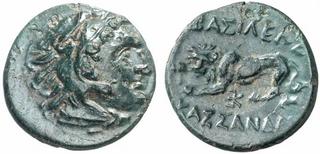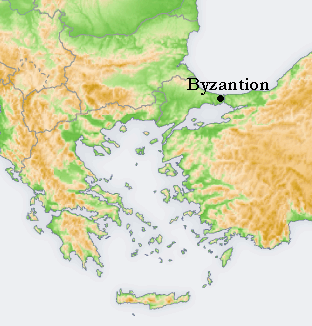
The Seleucid dynasty or the Seleucidae was a Macedonian Greek royal family, which ruled the Seleucid Empire based in West Asia during the Hellenistic period. It was founded by Seleucus I Nicator, a general and successor of Alexander the Great, after the division of the Macedonian Empire as a result of the Wars of the Successors (Diadochi).

Demetrius I, called Poliorcetes, was a Macedonian Greek nobleman and military leader who became king of Macedon between 294–288 BC. A member of the Antigonid dynasty, he was the son of its founder, Antigonus I Monophthalmus and his wife Stratonice, as well as the first member of the family to rule Macedon in Hellenistic Greece.

Seleucus I Nicator was a Macedonian Greek general, officer and successor of Alexander the Great who went on to found the eponymous Seleucid Empire, led by the Seleucid dynasty. Initially a secondary player in the power struggles following Alexander's death, Seleucus rose to become the total ruler of Asia Minor, Syria, Mesopotamia, and the Iranian plateau, assuming the title of basileus (emperor). The Seleucid Empire was one of the major powers of the Hellenistic world, until it was overcome by the Roman Republic and Parthian Empire in the late second and early first centuries BC.

Antigonus I Monophthalmus was a Macedonian Greek general and successor of Alexander the Great. A prominent military leader in Alexander's army, he went on to control large parts of Alexander's former empire. He assumed the title of basileus (king) in 306 BC and reigned until his death. He was the founder of the Antigonid dynasty, which ruled over Macedonia until its conquest by the Roman Republic in 168 BC.

Cassander was king of the Ancient Greek kingdom of Macedonia from 305 BC until 297 BC, and de facto ruler of southern Greece from 317 BC until his death.

The Battle of Ipsus was fought between some of the Diadochi in 301 BC near the town of Ipsus in Phrygia. Antigonus I Monophthalmus, the Macedonian ruler of large parts of Asia, and his son Demetrius were pitted against the coalition of three other successors of Alexander: Cassander, ruler of Macedon; Lysimachus, ruler of Thrace; and Seleucus I Nicator, ruler of Babylonia and Persia. Only one of these leaders, Lysimachus, had actually been one of Alexander's somatophylakes.

The Wars of the Diadochi, or Wars of Alexander's Successors, were a series of conflicts fought between the generals of Alexander the Great, known as the Diadochi, over who would rule his empire following his death. The fighting occurred between 322 and 281 BC.

Eumenes was a Greek general and satrap. He participated in the Wars of Alexander the Great, serving as both Alexander's personal secretary and as a battlefield commander. He later was a participant in the Wars of the Diadochi as a supporter of the Macedonian Argead royal house. He was executed after the Battle of Gabiene in the winter of 316–315 BC.
Polyperchon, was a Macedonian Greek general who served both Philip II and Alexander the Great and then played an active role in the ensuing battles for control between Alexander's generals.
Peithon or Pithon was the son of Crateuas, a nobleman from Eordaia in western Macedonia. He was famous for being one of the bodyguards of Alexander the Great, becoming the later satrap of Media, and claiming to be one of the diadochi.
The Battle of Paraitakene took place during the wars of the successors of Alexander the Great between Antigonus I Monophthalmus and Eumenes. It was fought in 317 BC.

Battle of Gabiene was the second great battle between Antigonus Monophthalmus and Eumenes, two of Alexander the Great's successors. The battle was fought near Gabiene in Persia in the winter of 316-315 BC and ended the Second War of the Diadochi. It established Antigonus as the most powerful of the successors.
The Babylonian War was a conflict fought between 311–309 BC between Antigonus I Monophthalmus and Seleucus I Nicator, ending in a victory for Seleucus. This conflict ended any possibility of restoration of the former empire of Alexander the Great, a result confirmed in the Battle of Ipsus. The battle also marked the birth of the Seleucid Empire by giving Seleucus control over the eastern satrapies of Alexander's former territory.
The Battle of Orkynia was a battle in the wars of the successors of Alexander the Great between Antigonus I Monophthalmus and Eumenes. It was fought near Orkynia in Cappadocia in 319 BC and resulted in a stunning Antigonid victory.
The Battle of Cretopolis (Kretopolis) was a battle in the wars of the successors of Alexander the Great between general Antigonus Monopthalmus and the remnants of the Perdiccan faction. It was fought near Cretopolis in Pisidia in 319 BC and resulted in another stunning Antigonid victory.

The Battle of Byzantium (Byzantion) took place during the wars of the successors of Alexander the Great between the generals Antigonus Monopthalmus and Cleitus the White. It was a two-day-battle fought near Byzantium at the Hellespont in 317 BC and resulted in a stunning Antigonid victory.
The battle of the river Tigris was an engagement between the Diadochi Seleucus and the Antigonid general Nicanor, on the southern bank of the river Tigris in the year 311 BC. Nicanor was on route to recapture the city of Babylon from Seleucus, but he was defeated when Seleucus surprised him with an assault on his camp during the night, forcing Antigonus to cease hostilities with the other Diadochi, in order to concentrate his efforts on recapturing the city of Babylon himself.
The First Siege of Babylon was a successful siege of one of its citadels, loyal to Antigonus, by forces under Seleucus in 311 BC.
The Second siege of Babylon took place during the Babylonian War in 310 BC. Antigonid forces under Antigonus's oldest son, Demetrius, besieged the Seleucid garrison of the city of Babylon under the command of Patrocles.
The Third siege of Babylon took place during Antigonus I Monophthalmus' expedition to the Seleucid domain in the context of the Babylonian War.







